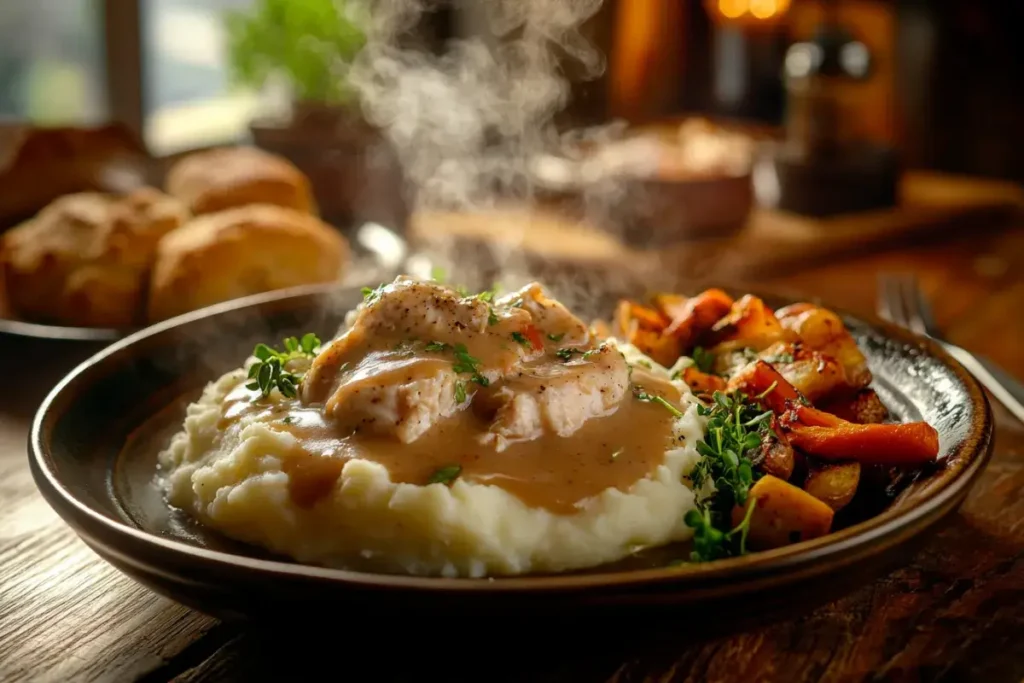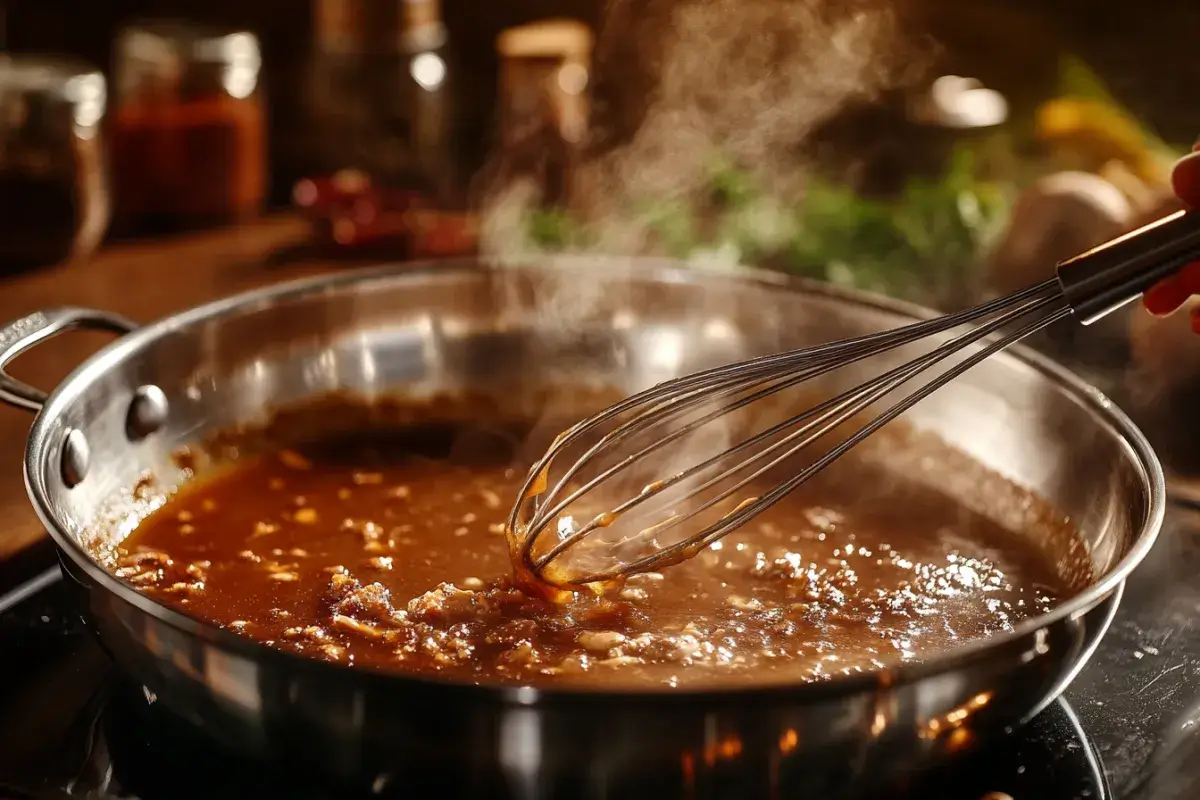Chicken gravy is a savory sauce that complements many dishes, adding moisture and flavor to meals like mashed potatoes, roasted chicken, and biscuits. It’s one of those staples that can elevate a simple meal into something truly delicious. But have you ever wondered, what is chicken gravy made of? Whether you prefer a homemade version or reach for store-bought, understanding the ingredients can help you make the perfect gravy every time.
The Basic Ingredients in Chicken Gravy
The core of any chicken gravy recipe starts with a few simple ingredients. These form the foundation of the rich, smooth texture and savory flavor that makes chicken gravy a beloved addition to many meals.
Chicken Drippings or Broth
One of the most important components of chicken gravy is chicken drippings or broth. When you roast a chicken, the juices that collect at the bottom of the pan can be used to make the base of your gravy. If you don’t have chicken drippings, a good quality chicken broth works just as well. The fat and flavors from the chicken add depth, creating a gravy that’s much richer than using water.
Fat (Butter or Oil)
To achieve the right consistency, you’ll need a source of fat, typically butter or oil. Fat helps bind the ingredients and gives your gravy a smooth and velvety texture. Butter is the most common fat used in making gravy, but for those who prefer a dairy-free alternative, oil can be substituted. The key is to melt the fat before adding flour, which helps create the roux that thickens the gravy.
Flour (Thickening Agent)
The thickening agent in chicken gravy is usually flour. It is combined with the fat to create a roux, which acts as the base for the gravy. The longer you cook the roux, the darker and richer your gravy will become. Flour not only thickens the sauce but also gives it body and structure, preventing it from becoming too thin or watery.
Additional Ingredients to Enhance Flavor
While the basic ingredients create the foundation, this gravy can be enhanced with a few extra ingredients to bring out even more flavor. These additions are often what make one gravy recipe stand out from another.
Salt and Pepper
Seasoning your gravy with salt and pepper is essential. Salt enhances all the natural flavors in the gravy, while pepper adds a touch of spice and complexity. Adjust these to taste after your gravy has thickened to ensure a well-balanced flavor.
Herbs (Thyme, Parsley, Sage)
For an herbaceous boost, you can add herbs like thyme, parsley, or sage. These herbs provide a subtle earthiness that pairs perfectly with the savory flavors of the chicken. Fresh or dried herbs can be used, but make sure to add them during the simmering stage to allow their flavors to meld into the gravy.
Garlic and Onion (Fresh or Powdered)
To add a deeper umami flavor, some cooks like to include garlic or onion—either fresh or powdered. Fresh garlic and onion should be sautéed in butter before the flour is added, while the powdered versions can be sprinkled in during the seasoning stage. These ingredients offer a depth of flavor that enhances the overall richness of the gravy.
Types of Chicken Gravy: Varieties and Variations
Gravy isn’t a one-size-fits-all dish. Depending on your preferences or dietary needs, there are several variations to consider. Here are some popular types of chicken gravy:

Classic Homestyle Chicken Gravy
This is the traditional version made with chicken drippings, butter, flour, and seasonings. It’s the type of gravy you’d expect to see on a Thanksgiving dinner table or poured over a plate of fried chicken. The balance of savory and creamy flavors makes this a family favorite.
Creamy Chicken Gravy
For those who enjoy a richer texture, creamy chicken gravy is a wonderful option. This variation often includes milk or cream to add extra richness. The inclusion of dairy gives the gravy a silkier texture, perfect for serving over mashed potatoes or biscuits.
Gluten-Free and Dairy-Free Alternatives
If you’re avoiding gluten or dairy, there are still plenty of ways to enjoy chicken gravy. For a gluten-free version, substitute flour with cornstarch or another gluten-free thickening agent like arrowroot powder. Dairy-free options can use oil or dairy-free butter instead of traditional butter, and you can swap out cream or milk with plant-based milk, such as almond or oat milk. Check out this gluten-free gravy recipe for more ideas.
How to Make Chicken Gravy From Scratch
Making this gravy from scratch is easier than you might think. With a few key steps, you’ll be able to whip up a delicious, smooth gravy in no time.
Step 1: Collecting Chicken Drippings
Start by collecting the drippings from your roasted chicken. If you don’t have enough drippings, supplement with chicken broth. Strain the drippings to remove any solid bits for a smoother texture.
Step 2: Preparing the Roux (Fat and Flour)
In a medium saucepan, melt butter or heat oil over medium heat. Once hot, whisk in flour to create a roux. Stir continuously for a few minutes until the fat fully absorbs the flour and it turns golden brown.
Step 3: Adding Chicken Stock or Broth
Slowly pour in your chicken broth while whisking continuously. This helps to avoid lumps. Bring the mixture to a simmer and allow it to thicken for several minutes.
Step 4: Seasoning and Adjusting Consistency
Finally, add salt, pepper, and any additional herbs or spices you desire. If the gravy is too thick, add more broth to thin it out. For a thicker consistency, let it simmer longer. For more flavor-enhancing tips, read these expert tips on improving chicken gravy.
Common Mistakes When Making Chicken Gravy
Even with a simple recipe, mistakes can happen. Here are a few common issues people face when making chicken gravy, and how to avoid them:
- Lumpy Gravy: To avoid lumps, always whisk your flour thoroughly when adding it to the fat, and slowly pour in the broth while whisking continuously.
- Over-Thickened Gravy: If If the gravy thickens too much, add more broth or water gradually until you reach the desired consistency.
- Bland Gravy: Gravy can sometimes turn out bland if it’s under-seasoned. Always taste your gravy at the end and adjust the salt, pepper, and any additional spices as needed.
How to Store and Reheat Chicken Gravy
Proper storage and reheating will keep your gravy tasting fresh and delicious. Once your gravy has cooled, store it in an airtight container in the refrigerator for up to three days. When reheating, warm it gently on the stove over low heat, stirring occasionally. If the gravy thickens too much in the fridge, you can thin it with a little bit of chicken broth or water as it heats.
How to Thicken or Thin Chicken Gravy
Achieving the perfect consistency for your chicken gravy is key to making it delicious. Whether your gravy turns out too thin or too thick, there are simple solutions to get it just right.
Using Cornstarch
If your gravy is too thin, cornstarch can be an excellent thickener. Unlike flour, cornstarch needs to be mixed with cold water or broth before adding it to the gravy to prevent lumps. Simply combine 1 tablespoon of cornstarch with 2 tablespoons of cold liquid, mix until smooth, and then slowly whisk it into your simmering gravy. Let it simmer for a few minutes until it thickens to your preferred consistency.
Adding More Roux
Another way to thicken your gravy is by adding more roux (the fat and flour mixture). If you notice that your gravy is too runny, melt a small amount of butter in a separate pan, stir in an equal amount of flour, and then whisk the roux into your gravy. This will thicken it without altering the flavor too much.
Techniques for Thinning Gravy
On the flip side, if your gravy is too thick, it’s easy to fix. Add a bit more chicken broth, water, or even milk, depending on the flavor you’re aiming for. Whisk in the liquid a little at a time until your gravy reaches the desired consistency.
Health Considerations for Chicken Gravy
While chicken gravy can be delicious, it’s important to consider its nutritional impact. Depending on the ingredients used, gravy can be relatively high in fat and sodium, especially when made from drippings or store-bought options.
Healthier Alternatives
If you’re looking for ways to make healthier chicken gravy, consider using low-sodium broth and less butter or oil. You can also thicken your gravy with cornstarch instead of flour to reduce the calorie count. Another healthy tweak is to use olive oil or other healthier fats as a replacement for butter. This adds healthy unsaturated fats without sacrificing much flavor.
Reducing Sodium or Fat Content
To reduce sodium, opt for homemade broth made with no added salt, or choose low-sodium chicken broth options available at the store. Additionally, minimizing the amount of butter or using a fat alternative like plant-based oils can help cut back on the fat content. For a lighter version, consider substituting milk with a lower-fat alternative, such as skim milk or a dairy-free option like almond milk.
Popular Dishes Served with Chicken Gravy
Chicken gravy is incredibly versatile and pairs well with a wide range of dishes. Here are a few of the most popular meals that are even better with a generous drizzle of homemade chicken gravy:

- Mashed Potatoes: This is the classic pairing. The creamy texture of mashed potatoes perfectly complements the rich, savory flavors of chicken gravy.
- Biscuits and Gravy: A breakfast favorite, especially in Southern cuisine, where the gravy is often served over warm, flaky biscuits.
- Roasted Chicken: Chicken gravy is a natural companion for roasted chicken, helping to keep the meat moist and adding depth of flavor.
- Fried Chicken: Whether it’s Southern fried chicken or any other style, chicken gravy adds an extra layer of flavor to crispy, fried pieces.
Homemade vs. Store-Bought Chicken Gravy
When it comes to chicken gravy, you might be wondering whether homemade or store-bought options are better. Both have their merits, but there are key differences worth noting.
Taste Comparison
Homemade gravy tends to have a richer and more authentic flavor because it’s made from scratch, often using drippings from the chicken. You can adjust the seasoning to your liking and control the ingredients. In contrast, store-bought gravies can sometimes taste more processed or overly salty due to preservatives.
Nutritional Comparison
When comparing the nutritional profiles, homemade gravy usually comes out on top. You can control the amount of sodium, fat, and calories by choosing your ingredients wisely. Store-bought gravies often contain added preservatives and can be higher in sodium and fat. For those seeking convenience, though, store-bought is a quick option, especially for large gatherings or busy weeknights.
Chicken Gravy: Gluten-Free and Dairy-Free Options
For people with dietary restrictions, making chicken gravy can seem like a challenge, but there are excellent substitutes for both gluten and dairy.
Substitutes for Flour (Gluten-Free)
If you need a gluten-free gravy, there are many alternatives to flour, such as cornstarch, arrowroot powder, or even gluten-free flour blends. Each of these options can thicken gravy just as well as traditional flour. Cornstarch, for instance, is easy to use and gives the gravy a smooth, glossy finish.
Dairy-Free Butter Alternatives
Those avoiding dairy can easily substitute the butter in gravy recipes with plant-based butter or even oils like olive or avocado oil. These alternatives allow you to make a gravy that’s just as rich and flavorful without any dairy content.
Best Tips for Perfect Chicken Gravy Every Time
Making the perfect chicken gravy takes practice, but here are some tips to ensure you get it right every time:
- Whisk Continuously: One of the easiest ways to prevent lumps is to keep whisking, especially when adding the liquid to your roux. This will help create a smooth consistency.
- Maintain the Right Heat: Don’t rush the process by using high heat. Medium heat allows the flavors to develop while preventing the gravy from scorching. Medium heat allows the flavors to develop while preventing the gravy from scorching. See how these tips work in this delicious chicken and gravy recipe.
- Add Ingredients in the Right Order: Start with your fat and flour (roux), then slowly add the liquid, whisking continuously. This helps the gravy thicken evenly without separating.
FAQs About Chicken Gravy
Can I Make Chicken Gravy Without Drippings?
Yes, you can make delicious chicken gravy without drippings by using high-quality chicken broth as a base. Combine it with butter, flour, and your preferred seasonings, and you’ll have a flavorful gravy without needing drippings.
How Do I Prevent Lumpy Gravy?
The key to preventing lumpy gravy is to add the liquid slowly while constantly whisking. Using a whisk instead of a spoon helps break up any potential clumps as you add the broth to your roux.
Can I Freeze Chicken Gravy?
Yes, you can freeze chicken gravy for up to three months. Just make sure to store it in an airtight container. When reheating, thaw it in the refrigerator and heat gently on the stove while stirring occasionally.
Conclusion: Mastering the Art of Chicken Gravy
Making chicken gravy may seem simple, but mastering the perfect recipe requires attention to detail. By using the right ingredients and following careful steps, you can create a gravy that enhances any dish. Whether you’re aiming for a classic homestyle version or adapting it to suit dietary needs, chicken gravy is a versatile and essential sauce in many kitchens. Don’t be afraid to experiment with herbs, spices, and methods to find the version that works best for you.

